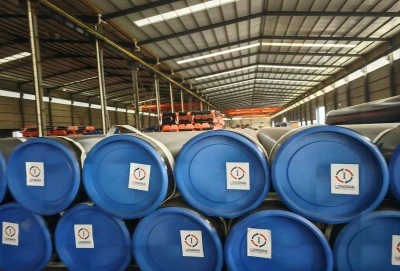Welding is a critical process in the construction and maintenance of pipelines, particularly when dealing with high-grade materials like API 5L X52 PSL2 pipes. The quality of welding can significantly impact the overall performance, safety, and longevity of the pipeline. In this comprehensive guide, we'll explore the key technical points for improving the welding quality of API 5L X52 PSL2 pipelines, focusing on effective welding techniques, heat input control, and the role of filler materials.
|
|
|
What welding techniques are most effective for API 5L X52 PSL2 pipelines?
When it comes to welding API 5L X52 PSL2 pipes, several techniques have proven to be particularly effective. Each method has its own set of advantages and is suited to different aspects of pipeline construction and repair.
1. Gas Tungsten Arc Welding (GTAW)
GTAW, also known as TIG welding, is renowned for its precision and ability to produce high-quality welds. This technique is particularly useful for root passes in pipeline welding, where a clean, strong foundation is crucial.
Key benefits of GTAW for API 5L X52 PSL2 pipelines include:
- Excellent control over heat input
- High-quality, clean welds with minimal spatter
- Ability to weld thin materials without distortion
- Superior weld appearance and consistency
To optimize GTAW for API 5L X52 PSL2 pipes, welders should:
- Use pure argon or helium as shielding gas for optimal arc stability
- Select the appropriate tungsten electrode type and size
- Maintain a consistent arc length and travel speed
- Implement proper cleaning procedures to ensure weld quality
2. Shielded Metal Arc Welding (SMAW)
SMAW, or stick welding, is a versatile technique widely used in pipeline construction due to its portability and ability to work in various weather conditions.
Advantages of SMAW for API 5L X52 PSL2 pipeline welding include:
- Suitability for outdoor and remote locations
- Ability to weld in all positions
- Cost-effectiveness and simplicity of equipment
- Good performance on rusty or dirty materials
To enhance SMAW performance on API 5L X52 PSL2 pipes:
- Choose the appropriate electrode type and size for the specific application
- Maintain proper arc length and electrode angle
- Control travel speed to ensure adequate penetration and fusion
- Implement proper interpass cleaning and temperature control
3. Gas Metal Arc Welding (GMAW)
GMAW, commonly referred to as MIG welding, offers high deposition rates and is excellent for filling and capping passes in pipeline welding.
Benefits of GMAW for API 5L X52 PSL2 pipeline welding:
- High productivity and efficiency
- Good weld appearance with minimal slag
- Suitable for a wide range of material thicknesses
- Easy to automate for increased consistency
To optimize GMAW for API 5L X52 PSL2 pipes:
- Select the appropriate wire type and diameter
- Use the correct shielding gas mixture for the application
- Maintain proper wire stick-out and travel angle
- Implement pulsed GMAW techniques for better control of heat input
4. Flux-Cored Arc Welding (FCAW)
FCAW combines elements of SMAW and GMAW, offering high deposition rates and good performance in outdoor conditions.
Advantages of FCAW for API 5L X52 PSL2 pipeline welding:
- High deposition rates for increased productivity
- Good performance in windy conditions
- Ability to weld thicker materials effectively
- Reduced sensitivity to surface contaminants
To enhance FCAW performance on API 5L X52 PSL2 pipes:
- Choose the appropriate flux-cored wire type for the application
- Maintain proper wire extension and travel angle
- Control travel speed to ensure adequate penetration and fusion
- Implement proper interpass cleaning and temperature control
By selecting the most appropriate welding technique and optimizing its application, welders can significantly improve the quality of welds on API 5L X52 PSL2 pipelines. However, technique selection is just one aspect of achieving high-quality welds. Proper heat input control is equally crucial, which brings us to our next section.
How to control heat input to enhance the weld integrity of API 5L X52 PSL2 pipes?
Heat input control is a critical factor in maintaining the integrity of welds on API 5L X52 PSL2 pipes. Proper heat management ensures optimal mechanical properties, minimizes distortion, and reduces the risk of weld defects. Let's explore some key strategies for controlling heat input during the welding process.
1. Understanding the Importance of Heat Input Control
Heat input directly affects the microstructure and properties of the weld and heat-affected zone (HAZ). For API 5L X52 PSL2 pipes, excessive heat input can lead to:
- Grain growth in the HAZ, reducing toughness
- Increased risk of hydrogen-induced cracking
- Excessive distortion and residual stresses
- Degradation of corrosion resistance
Conversely, insufficient heat input can result in:
- Lack of fusion or penetration
- Increased susceptibility to cold cracking
- Poor mechanical properties of the weld
2. Calculating and Monitoring Heat Input
Heat input is typically calculated using the following formula:
Heat Input = (Voltage × Amperage × 60) / (Travel Speed × 1000)
To effectively control heat input:
- Use welding parameter monitoring systems to track voltage, amperage, and travel speed in real-time
- Implement digital welding power sources with built-in heat input calculation features
- Train welders to manually calculate and record heat input for each weld pass
3. Preheat and Interpass Temperature Control
Proper preheat and interpass temperature control is crucial for managing heat input and preventing weld defects in API 5L X52 PSL2 pipes.
Key considerations include:
- Determine the appropriate preheat temperature based on material thickness and composition
- Use temperature-indicating crayons or infrared thermometers to monitor preheat and interpass temperatures
- Maintain consistent interpass temperatures throughout the welding process
- Implement proper cooling rates to achieve desired mechanical properties
4. Welding Sequence and Technique Optimization
The welding sequence and technique can significantly impact heat input and weld quality.
Strategies for optimization include:
- Implement stringer bead techniques instead of weaving for better heat control
- Use backstepping or block welding sequences to distribute heat more evenly
- Alternate weld passes between different sections of the joint to manage heat buildup
- Optimize travel speed and electrode manipulation to achieve the desired heat input
5. Advanced Heat Input Control Techniques
Several advanced techniques can be employed to further enhance heat input control:
- Pulsed welding: Alternating between high and low current pulses to reduce overall heat input while maintaining penetration
- Controlled short-circuit transfer: Utilizing advanced power source technology to precisely control the short-circuit phase of the welding cycle
- Narrow gap welding: Reducing the overall weld volume to minimize heat input and distortion
- Automated welding systems: Implementing robotics or mechanized welding equipment for consistent heat input control
By implementing these heat input control strategies, welders can significantly enhance the integrity and quality of welds on API 5L X52 PSL2 pipelines. However, heat input control is just one piece of the puzzle. The selection and proper use of filler materials also play a crucial role in achieving high-quality welds, which we'll explore in the next section.
What role do filler materials play in the welding quality of API 5L X52 PSL2 pipelines?
Filler materials are a critical component in the welding process of API 5L X52 PSL2 pipes, significantly influencing the final weld quality, mechanical properties, and overall performance of the pipeline. Let's delve into the various aspects of filler materials and their impact on welding quality.
1. Matching Filler Material Properties
Selecting the appropriate filler material is crucial for achieving optimal weld properties. For API 5L X52 PSL2 pipes, the filler material should generally match or slightly overmatch the base metal's mechanical properties.
Key considerations include:
- Tensile strength: The filler material should have a tensile strength equal to or slightly higher than the base metal
- Yield strength: Ensure the filler material's yield strength is compatible with the base metal
- Elongation: The filler material should provide adequate ductility to prevent brittle fracture
- Impact toughness: Select filler materials that offer appropriate impact toughness for the service conditions
2. Chemical Composition Compatibility
The chemical composition of the filler material plays a crucial role in achieving a sound weld and preventing various defects.
Important factors to consider:
- Carbon equivalent: Ensure the filler material's carbon equivalent is compatible with the base metal to prevent cold cracking
- Alloying elements: Match key alloying elements to maintain corrosion resistance and mechanical properties
- Low hydrogen content: Use low-hydrogen filler materials to minimize the risk of hydrogen-induced cracking
- Deoxidizers: Ensure adequate deoxidizers are present to prevent porosity and improve weld quality
3. Filler Material Selection for Different Welding Processes
Different welding processes require specific types of filler materials. For API 5L X52 PSL2 pipeline welding, common filler material types include:
- SMAW: Covered electrodes (e.g., E7018, E8018)
- GMAW: Solid wire electrodes (e.g., ER70S-6, ER80S-D2)
- FCAW: Flux-cored wires (e.g., E71T-1, E81T1-Ni1)
- GTAW: Bare filler rods (e.g., ER70S-2, ER80S-D2)
Select the appropriate filler material based on the welding process, joint design, and service requirements of the API 5L X52 PSL2 pipeline.
4. Impact of Filler Materials on Weld Microstructure
The filler material significantly influences the weld metal microstructure, which in turn affects the mechanical properties and performance of the weld.
Key microstructural considerations:
- Acicular ferrite formation: Filler materials that promote acicular ferrite formation can enhance weld toughness
- Grain refinement: Select filler materials with grain refining elements to improve mechanical properties
- Inclusion control: Use filler materials designed to produce fine, evenly distributed inclusions for improved toughness
- Bainite formation: Some filler materials promote bainitic microstructures, offering a good balance of strength and toughness
5. Handling and Storage of Filler Materials
Proper handling and storage of filler materials are crucial for maintaining their quality and performance.
Best practices include:
- Store filler materials in a clean, dry environment to prevent moisture absorption
- Follow manufacturer recommendations for storage temperatures and humidity levels
- Implement proper inventory management to ensure filler materials are used before their expiration date
- Use holding ovens or heated quivers to maintain low hydrogen levels in covered electrodes
6. Filler Material Testing and Qualification
To ensure the suitability of filler materials for API 5L X52 PSL2 pipeline welding, implement a comprehensive testing and qualification program.
Key testing procedures may include:
- Mechanical property testing (tensile, impact, hardness)
- Chemical composition analysis
- Diffusible hydrogen testing
- Weldability tests (e.g., Tekken, CTS, or Cruciform tests)
- Corrosion resistance testing (if applicable)
By carefully selecting, handling, and qualifying filler materials, welders can significantly enhance the quality and performance of welds on API 5L X52 PSL2 pipelines. The proper use of filler materials, combined with effective welding techniques and heat input control, forms the foundation for achieving high-quality, reliable welds in pipeline construction and maintenance.
In conclusion, improving the welding quality of API 5L X52 PSL2 pipelines requires a multifaceted approach that encompasses proper welding technique selection, effective heat input control, and careful consideration of filler materials. By focusing on these key technical points, pipeline constructors and maintenance teams can ensure the longevity, safety, and performance of their API 5L X52 PSL2 pipeline systems.
For more information on our API 5L X52 PSL2 Pipes and expert guidance on welding techniques, please don't hesitate to contact our team at info@longma-group.com. We're here to support you in achieving the highest standards of welding quality for your pipeline projects.














